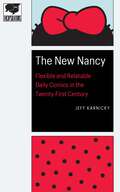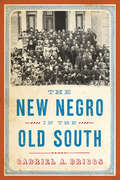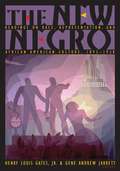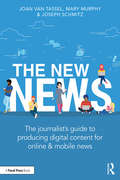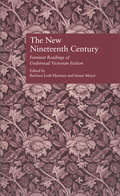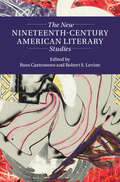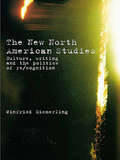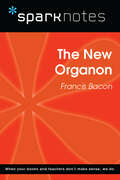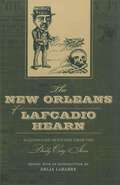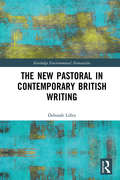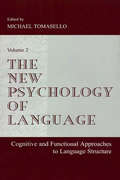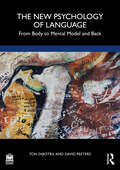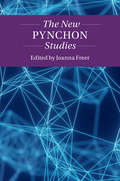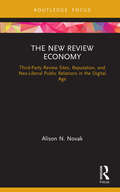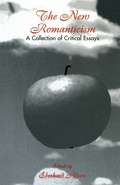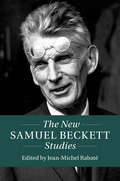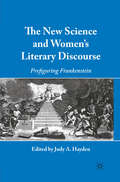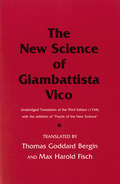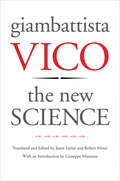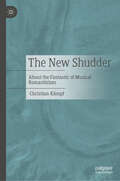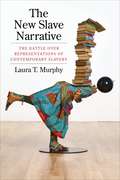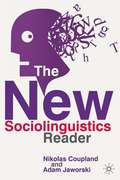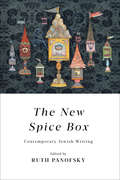- Table View
- List View
The New Nancy: Flexible and Relatable Daily Comics in the Twenty-First Century (Encapsulations: Critical Comics Studies)
by Jeff KarnickyIn The New Nancy Jeff Karnicky explores how today&’s successful daily comic strips are flexible and relatable, and he uses Olivia Jaimes&’s 2018 reboot of the long-running comic strip Nancy to illustrate the ways that contemporary comics have adapted to twenty-first-century technology and culture. Because comic creation has become part of the gig economy, flexible comics must be accessible to both online and print readers, and they must quickly grab readers&’ attention. Flexible comic creators like Jaimes must focus both on the work of producing comics and on building an audience. Daily comics also must form a relatable connection with readers. Most contemporary comic creators cultivate an online persona through which they engage readers with specific identities, beliefs, and expectations. This work might form a mutually beneficial bond that results in a successful daily comic strip, but it risks becoming fraught, toxic, and sometimes even dangerous. Jaimes cultivates a relatable persona in connection with longtime readers and new fans. Nancy finds its humor in both nostalgic objects (like cookie jars) and contemporary technological objects (like smartphones). Rebooted comic strips like Nancy directly confront the stereotypical representations that haunt the past of comics. Focusing on Nancy&’s role in contemporary culture, Karnicky uses literary studies, cultural studies, and media studies to argue that Jaimes&’s comic strip has something to say about comics, contemporary culture, and the intersection of the two.
The New Negro in the Old South
by Gabriel A. BriggsStandard narratives of early twentieth-century African American history credit the Great Migration of southern blacks to northern metropolises for the emergence of the New Negro, an educated, upwardly mobile sophisticate very different from his forebears. Yet this conventional history overlooks the cultural accomplishments of an earlier generation, in the black communities that flourished within southern cities immediately after Reconstruction. In this groundbreaking historical study, Gabriel A. Briggs makes the compelling case that the New Negro first emerged long before the Great Migration to the North. The New Negro in the Old South reconstructs the vibrant black community that developed in Nashville after the Civil War, demonstrating how it played a pivotal role in shaping the economic, intellectual, social, and political lives of African Americans in subsequent decades. Drawing from extensive archival research, Briggs investigates what made Nashville so unique and reveals how it served as a formative environment for major black intellectuals like Sutton Griggs and W.E.B. Du Bois. The New Negro in the Old South makes the past come alive as it vividly recounts little-remembered episodes in black history, from the migration of Colored Infantry veterans in the late 1860s to the Fisk University protests of 1925. Along the way, it gives readers a new appreciation for the sophistication, determination, and bravery of African Americans in the decades between the Civil War and the Harlem Renaissance.
The New Negro: Readings on Race, Representation, and African American Culture, 1892-1938
by Henry Louis Gates, Jr. & Gene Andrew JarrettWhen African American intellectuals announced the birth of the "New Negro" around the turn of the twentieth century, they were attempting through a bold act of renaming to change the way blacks were depicted and perceived in America. By challenging stereotypes of the Old Negro, and declaring that the New Negro was capable of high achievement, black writers tried to revolutionize how whites viewed blacks--and how blacks viewed themselves. Nothing less than a strategy to re-create the public face of "the race," the New Negro became a dominant figure of racial uplift between Reconstruction and World War II, as well as a central idea of the Harlem, or New Negro, Renaissance. Edited by Henry Louis Gates, Jr., and Gene Andrew Jarrett, The New Negro collects more than one hundred canonical and lesser-known essays published between 1892 and 1938 that examine the issues of race and representation in African American culture. These readings--by writers including W.E.B. Du Bois, Paul Laurence Dunbar, Alain Locke, Carl Van Vechten, Zora Neale Hurston, and Richard Wright--discuss the trope of the New Negro, and the milieu in which this figure existed, from almost every conceivable angle. Political essays are joined by essays on African American fiction, poetry, drama, music, painting, and sculpture. More than fascinating historical documents, these essays remain essential to the way African American identity and history are still understood today.
The New News: The Journalist’s Guide to Producing Digital Content for Online & Mobile News
by Joan Van Tassel Murphy Mary Joseph SchmitzThe New News offers an approachable, practical guide to the 21st-century newsroom, equipping journalists with the skills needed to work expertly, accurately, and efficiently across multiple media platforms. Emphasizing the importance of verification and authentication, the book shows how journalists adapt traditional practices of information-gathering, observation, interviewing, and newswriting for online publications. The text includes comprehensive coverage of key digital and multimedia competencies – capturing multimedia content, "doing" data journalism, mobile reporting, working in teams, participating with global audiences, and building a personal brand. Features developed exclusively for this book include innovative visuals showing the multimedia news structures and workflows used in modern newsrooms; interviews with prominent journalists about their experiences in contemporary journalism; a glossary of up-to-date terms relevant to online journalism; and practical exercises and activities for classroom use, as well as additional downloadable online instructor materials. The New News provides excellent resources to help journalism students and early-career professionals succeed in today’s digital networked news industry. The authors are donating all royalties to nonprofit LION's programs to support local online news publications.
The New Nineteenth Century: Feminist Readings of Underread Victorian Fiction (Wellesley Studies in Critical Theory, Literary History and Culture #Vol. 14)
by Susan Meyer Barbara Leah HarmanThis book includes essays on writers from the 1840s to the 1890s, well known writers such as Anne Bronte, Wilkie Collins and Bram Stoker, lesser known writers such as Geraldine Jewsbury, Charles Reade, Margaret Oliphant, George Moore, Sarah Grand and Mary Ward. The contributors explore important thematic concerns: the relation between private and public realms; gender and social class; sexuality and the marketplace; and male and female cultural identity.
The New Nineteenth-Century American Literary Studies (Twenty-First-Century Critical Revisions)
by Robert S. Levine Russ CastronovoThe New Nineteenth-Century American Literary Studies takes stock of critical developments over the past twenty years, offering a fresh examination of key interpretative issues in this field. In eclectic fashion, it presents a wide range of new approaches in such areas as print and material culture, Black studies, Latinx studies, disability studies, gender and sexuality studies, postsecular studies, and Indigenous studies. This volume also maps out new directions for the future of the field. The evidence and examples discussed by the contributors are compelling, grounded in case studies of key literary texts, both familiar and understudied, that help to bring critical debate into focus and model fresh interpretive perspectives. Essays provide new readings and framings of such figures as Herman Melville, Harriet Wilson, Charles Chesnutt, Edgar Allan Poe, Washington Irving, and Zitkála-Šá.
The New North American Studies: Culture, Writing and the Politics of Re/Cognition
by Winfried SiemerlingWinner of the English Book Award, Grand Prix du Livre 2006 de la Ville de Sherbrooke. In this original and groundbreaking study, Winfried Siemerling examines the complexities of recognition and identity, rejecting previous nationalized thinking to approach North American cultural transformations from transnational and interdisciplinary perspectives. Using material from the United States and Canada as case studies and drawing on a wide range of texts and theorists, he examines postcoloniality and cultural emergence from the sixties to the present against earlier backgrounds. Siemerling's argument for a retheorization of the field takes on the full history of multiculturalism debates, including radical readings of W.E.B. Du Bois and Charles Taylor and their relation to G.W.F. Hegel, and challenging many of the models of multiculturalism in use today. Tackling controversial subjects such as identity politics, The New North American Studies proposes a fresh outlook on the most central issues of North American cultural politics, from debates on canon formation to the role of racial and linguistic difference. Concluding with a look at the future of cultural difference, Winfried Siemerling's study is an innovative rethinking of the whole field of North American Studies.
The New Organon (SparkNotes Philosophy Guide)
by SparkNotesThe New Organon (SparkNotes Philosophy Guide) Making the reading experience fun! SparkNotes Philosophy Guides are one-stop guides to the great works of philosophy–masterpieces that stand at the foundations of Western thought. Inside each Philosophy Guide you&’ll find insightful overviews of great philosophical works of the Western world.
The New Orleans of Lafcadio Hearn: Illustrated Sketches from the Daily City Item (Library of Southern Civilization)
by Delia LaBarreLafcadio Hearn (1850--1904) was a master satirist who displayed a fiery wit both as a writer and as an artist. For seven months in 1880, he surprised and amused the readers of New Orleans with his wood-block "cartoons" and accompanying articles, which were variously funny, scathing, surreal, political, whimsical, and moral. This delightful book collects in their entirety, for the first time, all of the extant satirical columns and woodcut illustrations published in the Daily City Item -- 181 columns in all. Hearn displays immense range, illuminating in words and prints the unique culture of New Orleans, including its Creole history, debauched underworld, corrupt politicians, and voudou practitioners. The columns are expertly annotated by Delia LaBarre, who places them in their unique Crescent City context.With virtually no training in art of any kind, Hearn began creating his illustrations partly to boost the circulation of a small daily newspaper in a competitive market. He believed in the power of satirical cartoons to communicate big ideas in small spaces -- in particular, to reveal the habits, prejudices, and delusions of the current generation. Blind in his left eye (since a boyhood accident) and severely myopic in his right, Hearn nonetheless painstakingly carved out drawings on wood blocks with a penknife to be printed alongside his articles on the newspaper's letterpress. Hearn developed, from the first of these woodcuts to the last, a unique style that expressed the full range of his wit, from razor-sharp condemnation to tender affection.Hearn had a keen eye for the absurd, along with an extraordinary ability to modulate his criticism and praise in a continuum from cauterizing vitriol to palliative balm, from the heaviest sarcasm to the lightest wit. In the pieces collected here, there can be found a unifying thread: Hearn's love/hate relationship with the virtues and vices of New Orleans, a city that continually amused and amazed him.Born in Greece and raised in Ireland, Lafcadio Hearn immigrated to the United States as a teenager and became a newspaper reporter in Cincinnati, Ohio. When he married a black woman, an act that was illegal at the time, the newspaper fired him and Hearn relocated to New Orleans. In the early 1880s his contributions to national publications (like Harper's Weekly and Scribners Magazine) helped mold the popular image of New Orleans as a colorful place of decadence and hedonism. In 1888, Hearn left New Orleans for Japan, where he took the name Koizumi Yakumo and worked as a teacher, journalist, and writer. "And it may come to pass that I shall have stranger things to tell you; for this is a land of magical moons and of witches and of warlocks; and were I to tell you all that I have seen and heard in these years in this enchanted City of Dreams you would verily deem me mad rather than morbid." -- Lafcadio Hearn, 1880, describing New Orleans in a letter to a friend
The New Oxford Guide to Writing
by Thomas S. KaneMany books on writing tell you how to think more creatively, how to conjure up an idea from scratch. Many, once you have an idea, show you how to express it clearly and elegantly. And many handbooks offer reliable advice on the use of commas, semicolons, and so forth. But The New Oxford Guide to Writing does all three, so that no matter where you find yourself in the writing process--from the daunting look of a blank page, to the rough draft that needs shaping, to the small but important questions of punctuation--you will find what you need in one handy volume. <p><p> Highlighted by numerous examples of successful prose--including marvelous, brief excerpts from Mark Twain, Joan Didion, H.L. Mencken, E.B. White, and Annie Dillard--this stimulating volume covers the entire subject step-by-step, clearly and authoritatively. <p><p> Whether you write for business or for pleasure, whether you are a beginner or an experienced pro, The New Oxford Guide to Writing is an essential addition to your reference library, providing abundant assistance and encouragement to write with more clarity, more color, and more force.
The New Pastoral in Contemporary British Writing (Routledge Environmental Humanities)
by Deborah LilleyThis book identifies a major turn in contemporary British literature in response to environmental crisis. It argues that the pastoral is emerging as a new critical framework in which to explore the understanding of people and place in this context. The New Pastoral in Contemporary British Writing explores how the pastoral tradition has transformed as authors respond to our changing relationships with place in this period. Analysing the features common to new pastoral writing, it brings together a corpus of works from major authors including Ali Smith, Jim Crace, John Burnside, Kathleen Jamie, and Robert Macfarlane. This book argues that crises such as pollution and climate change have shifted our understandings of the key relationships of pastoral and the terms upon which they are based, giving new senses to its older oppositions between the human and the natural, the urban and the rural, and the past and the present. Furthermore, it shows that the versions of pastoral that ensue align with current ecocritical arguments produced by thinking through the individual, cultural, and ecological implications of environmental crisis. As a result, pastoral emerges as the crucial strategy in the re-imagining of the environment underway in contemporary British writing, the resurgence of interest in nature writing, the increasing attention towards place in literary fiction, and the development of ecological or ‘climate’ fiction. This book will be of great interest to students and scholars of English as well as those concerned with the interdisciplinary topics of the environmental humanities, including literary geographies, new nature writing, cultures of climate change and the Anthropocene, and ecologically-oriented theory.
The New Psychology of Language: Cognitive and Functional Approaches To Language Structure, Volume II (Psychology Press And Routledge Classic Editions Ser.)
by Tomasello MichaelFrom the point of view of psychology and cognitive science, much of modern linguistics is too formal and mathematical to be of much use. The newly emerging approaches to language termed, "Functional and Cognitive Linguistics," however, are much less formally oriented. Instead, functional and cognitive approaches to language structure are typically couched in terms already familiar to cognitive scientists: perception, attention, conceptualization, meaning, symbols, categories, schemas, perspectives, discourse context, social interaction, and communicative goals. The account of human linguistic competence emerging from this new paradigm should be extremely useful to scientists studying how human beings (not formal devices) comprehend, produce, and acquire natural languages. The current volume brings together 10 of the most important linguists in cognitive and functional linguistics whose work is often not easily available to those outside the field. In original contributions, each of these scholars focuses on an important aspect of human linguistic competence, with a special eye to readers who are not professional linguists. Of special importance to all of the contributions are the cognitive and social interactional processes that constitute human linguistic communication. The book is of special interest to psychologists, cognitive scientists, psycholinguists, and developmental psycholinguists, in addition to linguists taking a more psychological approach to language.
The New Psychology of Language: From Body to Mental Model and Back
by Ton Dijkstra David PeetersThis illuminating book offers an up-to-date introduction to the psychology of language, exploring aspects of language processing that have previously not been given centre stage such as the role of body and brain, social aspects of language use, and mental models. The New Psychology of Language presents an overarching theoretical account called the Language User Framework for discussing a wide variety of core language activities. How do we understand speech in conversations? How do we read books? How do we convert our thoughts into bodily signals (speech, gestures, facial expressions) when we speak? What happens in the mind and brain when we have mastered two or more languages? All these aspects of language use are discussed at the level of words and sentences, as well as text and discourse. Language is considered as an embodied, embedded, incremental cognitive activity aiming at the construction and communication of rich and dynamic mental models. Discussion boxes highlight controversies in the field; case studies and practical exercises provide insight into everyday examples; illustrations represent important models of language processing; and key findings come along with clear and concise chapter summaries. Special attention is paid to research techniques for investigating the psychology of language. This accessible book is essential reading for students in disciplines such as psychology, cognitive science and neuroscience, artificial intelligence, biology, the language and communication sciences, and media studies. It is also a useful resource for a lay audience with an interest in language and communication.
The New Pynchon Studies (Twenty-First-Century Critical Revisions)
by Joanna FreerThis book captures a cross-section of the most significant recent developments in criticism on one of the most challenging authors of our time. It brings together essays by a new generation of Pynchon critics alongside some more established names in the field, building on and moving beyond existing critical paradigms in the study of Pynchon's work. In a critical landscape in which the postmodernism of Pynchon's earlier novels has been thoroughly established, this collection presents fresh analytical methodologies and new perspectives on Pynchon's fiction informed by the more expansive, globalized, and politicized network models that undergird recent advances in American literary theory and criticism. The New Pynchon Studies illustrates how Pynchon's later novels, Against the Day, Inherent Vice, and Bleeding Edge, demand a re-orientation of our approach to his entire oeuvre and enables readers to trace lines of continuity and development in his writing from V. to the present day.
The New Review Economy: Third-Party Review Sites, Reputation, and Neo-Liberal Public Relations in the Digital Age (Routledge Focus on Public Relations)
by Alison N. NovakThis book examines third-party review sites (TPRS) and the intersection of the review economy and neoliberal public relations, in order to understand how users and organizations engage the 21st century global review economy. The author applies communication and digital media theories to evaluate contemporary case studies that challenge TPRS and control over digital reputation. Chapters analyze famous cases such as the Texas photographer who sued her clients for negative reviews and activists using Yelp to protest the hunt of "Cecil the Lion," to illustrate the complicated yet important role of TPRS in the review economy. Theories such as neoliberal public relations, digital dialogic communication and cultural intermediaries help explain the impact of reviews and how to apply lessons learned from infamous cases. This nuanced and up to date exploration of the contemporary review economy will offer insights and best practice for academic researchers and upper-level undergraduate students in public relations, digital media, or strategic communication programs.
The New Romanticism: A Collection of Critical Essays (Wellesley Studies in Critical Theory, Literary History and Culture #Vol. 2188)
by Eberhard AlsenThe New Romanticism is an overview of the romantic trend taken up by American novelists in the twentieth-century. Includes three classic essays by Saul bellow, Thomas Pyncheon, and Toni Morrison.
The New Routledge Companion to Science Fiction (Routledge Literature Companions)
by Mark Bould Sherryl Vint Andrew M. ButlerThe New Routledge Companion to Science Fiction provides an overview of the study of science fiction across multiple academic fields. It offers a new conceptualisation of the field today, marking the significant changes that have taken place in sf studies over the past 15 years.Building on the pioneering research in the first edition, the collection reorganises historical coverage of the genre to emphasise new geographical areas of cultural production and the growing importance of media beyond print. It also updates and expands the range of frameworks that are relevant to the study of science fiction. The periodisation has been reframed to include new chapters focusing on science fiction produced outside the Anglophone context, including South Asian, Latin American, Chinese and African diasporic science fiction. The contributors use both well- established critical and theoretical approaches and embrace a range of new ones, including biopolitics, climate crisis, critical ethnic studies, disability studies, energy humanities, game studies, medical humanities, new materialisms and sonic studies. This book is an invaluable resource for students and established scholars seeking to understand the vast range of engagements with science fiction in scholarship today.
The New Samuel Beckett Studies (Twenty-First-Century Critical Revisions)
by Jean-Michel RabatéThis collection explains developments within Beckett studies and why he has emerged as one of the most iconic writers of the twentieth century. It also proposes a new interpretive framework that explores both the expanded canon, which has doubled the volume of his works in the last ten years, and the new methods used to approach it. This book covers all the most recent approaches to the Beckett study, such as archival research, queer theory, mathematical readings of literature, neuro-scientific approaches, translation studies, and disability studies. These new approaches are shown to be relevant and necessary to provide a renewed understanding of the lasting value of Beckett's works.
The New Science and Women’s Literary Discourse
by Judy A. HaydenLooking at literary discourse, including poetry, fiction and non-fiction, diaries, and drama, this collection offers remarkable and fascinating examples of women writers who integrated scientific material in their literary narratives.
The New Science of Giambattista Vico
by Giambattista Vico Thomas Goddard Bergin Max Harold FischA pioneering treatise that aroused great controversy when it was first published in 1725, Vico's New Science is acknowledged today to be one of the few works of authentic genius in the history of social theory. It represents the most ambitious attempt before Comte at comprehensive science of human society and the most profound analysis of the class struggle prior to Marx.
The New Science: The First New Science (Cambridge Texts In The History Of Political Thought Ser.)
by Giambattista VicoA fresh translation of The New Science, with detailed footnotes that will help both the scholar and the new reader navigate Vico&’s masterpieceThe New Science is the major work of Italian philosopher Giambattista Vico. First published in 1725 and revised in 1730 and 1744, it calls for a reinterpretation of human civilization by tracing the stages of historical development shared by all societies. Almost unknown during his lifetime, the work had a profound influence on later thinkers, from Montesquieu and Marx to Joyce and Gadamer. This edition offers a fresh translation and detailed annotations which enable the reader to track Vico&’s multiple allusions to other texts. The introduction situates the work firmly within a contemporary context and newly establishes Vico as a thinker of modernity.
The New Shudder: About the Fantastic of Musical Romanticism
by Christian Kämpf"It is a new shudder, but not an old fear." Jean Paul's sentence contains an aesthetic of the fantastic in nuce. It is based not least on the philosophy of Friedrich Heinrich Jacobi and aims at the essence of Romanticism. In addition to works by Mozart, Beethoven, Schumann and Wagner, the Romantic magic opera by Spohr, Weber and Marschner are placed in the centre of interest against this background, as well as the music-aesthetic discourse accompanying them, which was led by Tieck, Hoffmann and Horn, A. B. Marx, Brendel and Pohl, are analysed. Contrary to the tradition of musicological research, which, if not taboo, at least trivialised the fantastic, Kämpf arrives at a new understanding of musical Romanticism, according to which it does not lose its affiliation with modernity and its impact on the present because of the fantastic, but only gains it.
The New Slave Narrative: The Battle Over Representations of Contemporary Slavery
by Laura MurphyA century and a half after the abolition of slavery in the United States, survivors of contemporary forms of enslavement from around the world have revived a powerful tool of the abolitionist movement: first-person narratives of slavery and freedom. Just as Frederick Douglass, Harriet Jacobs, and others used autobiographical testimonies in the fight to eradicate slavery, today’s new slave narrators play a crucial role in shaping an antislavery agenda. Their writings unveil the systemic underpinnings of global slavery while critiquing the precarity of their hard-fought freedom. At the same time, the demands of antislavery organizations, religious groups, and book publishers circumscribe the voices of the enslaved, coopting their narratives in support of alternative agendas.In this pathbreaking interdisciplinary study, Laura T. Murphy argues that the slave narrative has reemerged as a twenty-first-century genre that has gained new currency in the context of the memoir boom, post-9/11 anti-Islamic sentiment, and conservative family-values politics. She analyzes a diverse range of dozens of book-length accounts of modern slavery from Africa, Asia, the United States, the United Kingdom, and Europe, examining the narrative strategies that survivors of slavery employ to make their experiences legible and to promote a reinvigorated antislavery agenda. By putting these stories into conversation with one another, The New Slave Narrative reveals an emergent survivor-centered counterdiscourse of collaboration and systemic change that offers an urgent critique of the systems that maintain contemporary slavery, as well as of the human rights industry and the antislavery movement.
The New Sociolinguistics Reader (2nd Edition)
by Adam Jaworski Nikolas CouplandFully updated and expanded for the second edition, this core textbook provides rigorous coverage of the key themes and debates at the cutting edge of sociolinguistics research and brings together many of the most influential scholars in the field. Comprising six distinctive parts and almost fifty individual chapters, it introduces students to a wealth of issues in sociolinguistics, including refashioning linguistic identities, code-switching, language rights and the social functions of small talk. Chapters are richly illustrated with examples and informed by the latest scholarly debates.
The New Spice Box: Contemporary Jewish Writing
by Ruth PanofskyThe New Spice Box includes short fiction, personal essays, and poetry by Jewish writers from a broad range of cultural backgrounds. Fresh and relevant, profound and lasting, this anthology features works by acclaimed short story writers David Bezmozgis, Mireille Silcoff, and Ayelet Tsabari; groundbreaking memoirists Bernice Eisenstein and Alison Pick; and award-winning poets Isa Milman, Jacob Scheier, and Adam Sol. The driving force behind The New Spice Box is the desire to uncover the twin touchstones of original expression and writerly craft, and to balance the representation of genres, styles, and authorial perspectives. Here, authors summon the past as they probe their cultural inheritance and move forward into the future. The New Spice Box shows that Jewish literary tradition, Jewish experience, and Jewish identity can be expressed in innumerable ways.
